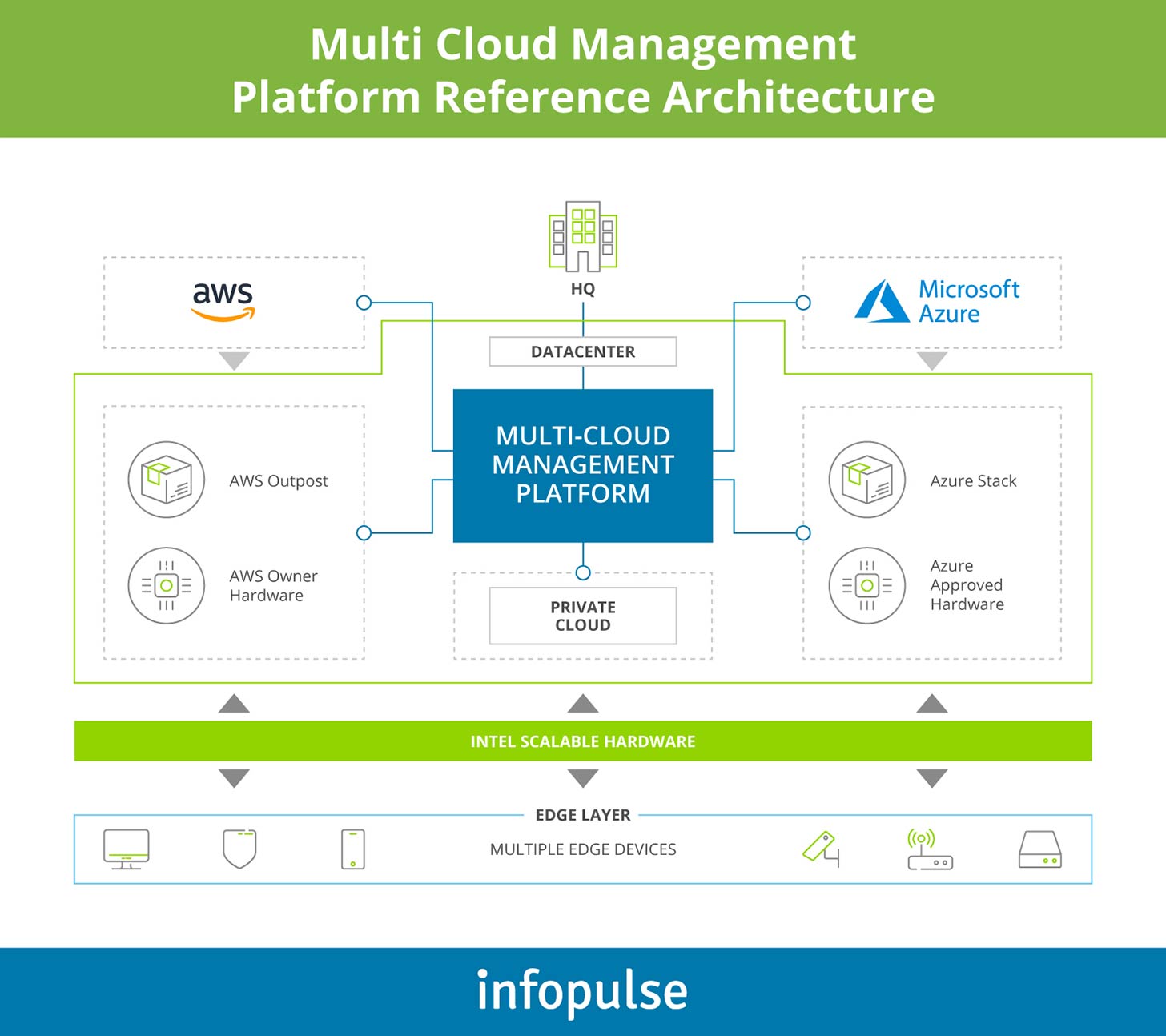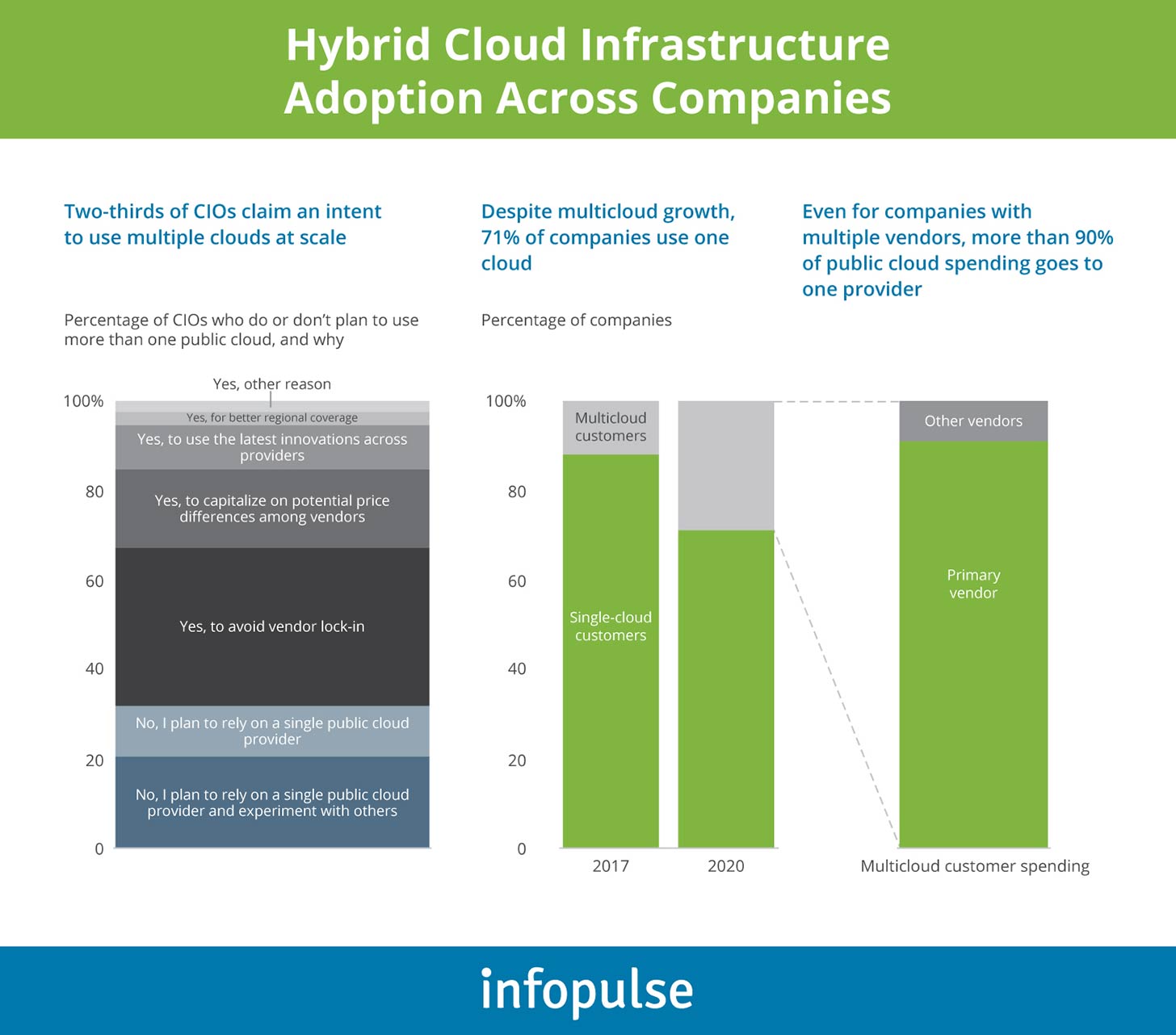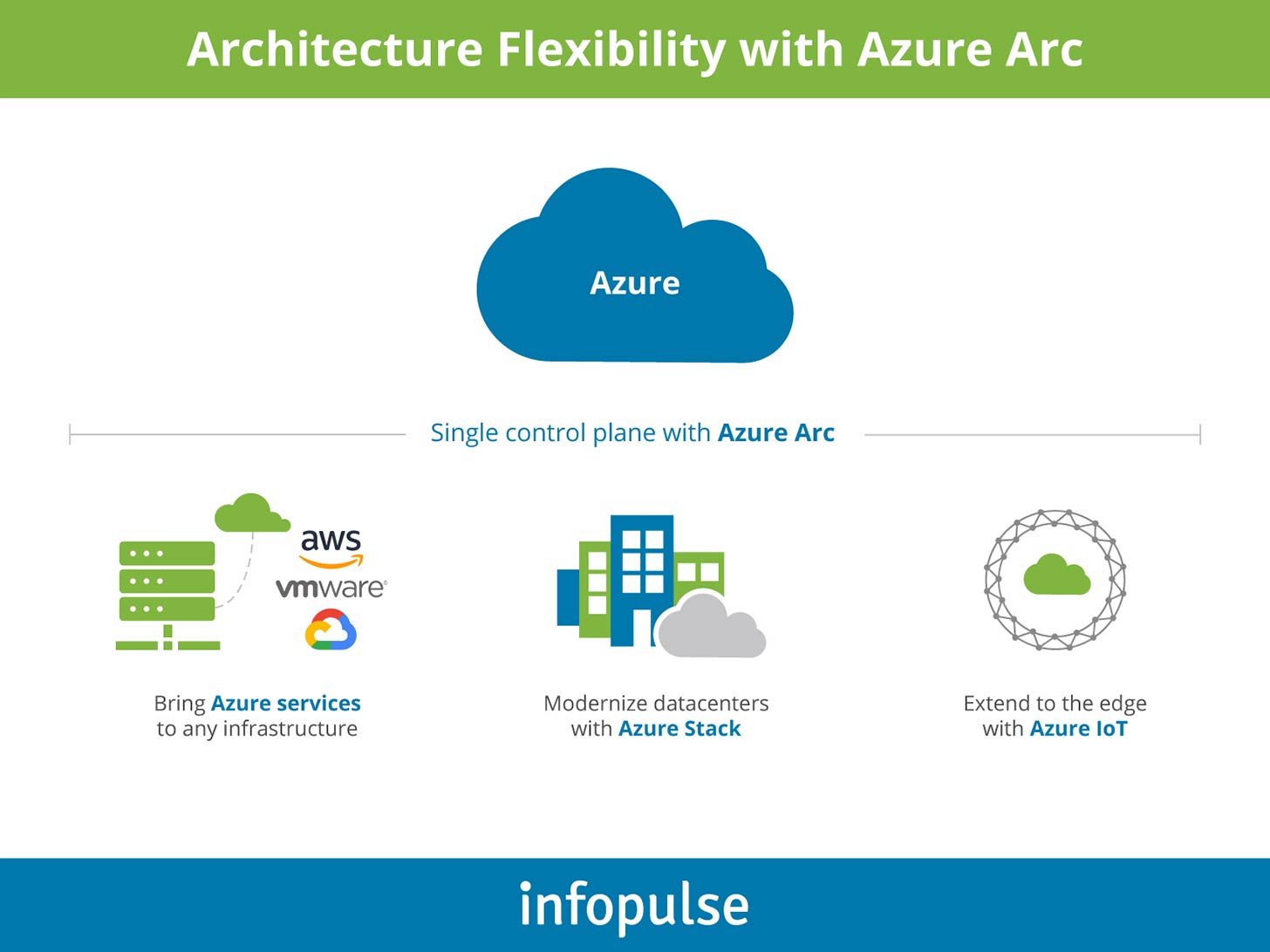Implementing a Hybrid Cloud Infrastructure in Azure: Use Cases and Benefits
In 2021, those plans are due for implementation as per cloud services providers’ recommendations. However, with a growing array of hybrid cloud solutions on the market, it can be hard to pin down the exact value proposition behind such offerings and chart a viable path for implementation.
What is Hybrid Cloud Infrastructure? The Benefits and Levels of Adoption
Commonly, hybrid cloud infrastructure is a combination of public, private, and, possibly, on-premises infrastructure or edge cloud services – orchestrated for unified, stable performance. Such a setup allows organizations to leverage the combined power of different cloud services to enable greater agility, cost efficiencies, and innovation.

Hybrid Cloud Benefits
- Flexibility and scalability: the hybrid cloud is the only route to effectively leveraging the best of public and private clouds. Enterprises can allocate different environments to different workflows based on load, security, and compliance requirements and effectively leverage an array of different IaaS, PaaS, and SaaS solutions whenever the need arises. In fact, 49% of tech leaders name the ability to assemble the “best of breed platforms and service options” as a primary driver behind hybrid cloud adoption.
- Agility and faster time-to-market: Hybrid cloud solutions enable quick and seamless provisioning of resources across the board to deploy innovative products to the market, built with the help of different cloud services within the portfolio.
- Opportunities for Innovation: Public cloud vendors are faster to launch innovative SaaS services and cloud-native products for everything from AI to Virtual Desktop management for their customers to leverage in their operations.
- Cost-efficiency: Arguably, the biggest downside of private and on-premises data centers is the high TCO bill. A proper approach to hybrid cloud infrastructure management can help curb expenditure on maintenance while also keeping public cloud spending at bay with smart controls and cloud cost optimization.
- Security and risk management: Not every type of data is well-suited for storage and operationalization via the public cloud. Even when it is, not every enterprise is ready to place it in the public cloud. A hybrid cloud strategy allows companies to create a smart allocation for data & workflows across different assets to diversify risks. According to IDC, hybrid cloud customers experience a 13% improvement in cloud security and risk reduction on average.
Hybrid Cloud Infrastructure Adoption Trends in 2021
An array of hybrid cloud deployment scenarios is possible: public + private cloud or multiple public clouds + private clouds. However, today, most leaders focus on leveraging one public cloud vendor and an array of supporting virtualization services for on-premises resources and ready-to-use SaaS solutions rather than combining multiple public clouds as Bain & Co data suggests.

This trend might seem to contradict the abovementioned data on hybrid cloud adoption patterns and statistics and requires further explanation. On average, an enterprise uses 53 supporting cloud platform services (such as products for Big Data analytics, IoT devices, ML, etc.) from the same vendor, according to the Bain & Co report. In turn, this makes it harder to migrate a single application to another infrastructure provider. While such a setup does create vendor-lock, there are also substantial advantages to staying with one public cloud services provider and complementing it with extra private cloud resources.
Microsoft with Azure has recommended itself as one of the leading public cloud vendors. Selected as a public cloud provider by 95% of Fortune 500 companies, Azure also provides a growing range of tools and infrastructure offerings to support hybrid cloud setups (cloud-to-cloud, cloud-to-edge, or cloud-to-on-premises).
In this post, we’d like to focus on the Microsoft Azure hybrid cloud-based solution benefits for enterprises.
Azure Hybrid Cloud Infrastructure Explained: Overview of the Main Azure Stack Products

Due to the increased demand, Microsoft Azure significantly expanded its hybrid cloud offerings in 2020.
As of 2021, Microsoft provides a consolidated stack of tools and services for setting up, managing, and orchestrating complex hybrid cloud infrastructure, spanning over multiple public clouds, private and on-premises data centers, and edge devices.
The definitive advantage is that you can run a hybrid cloud environment using a standard set of Azure tools such as Portal, PowerShell, DevOps, and Azure Resource Manager along with an array of hybrid cloud-specific services, namely Azure Stack and its sub-services:
- Microsoft Azure Stack: Azure Stack is an integrated platform that extends Azure public cloud to any local environment – a private data center, edge destination, or remote office. The purpose of Azure Stack is to facilitate the creation of a homogenous environment between cloud and on-premises and minimize the constraints of operating secure hybrid environments.
- Azure Stack Hub: With this product, you can seamlessly extend a range of Azure services such as Azure VMs, Azure App Service, Azure Active Directory, and more to on-premises resources. In essence, Azure Stack Hub lets you build an autonomous private cloud featuring tools, experiences, and app models from the Azure public cloud and deploy them privately or on edge.
- Azure Stack Edge: Positioned as a hardware-as-a-service solution, Azure Stack Edge lets you rent edge devices and manage end-to-end cloud-to-edge experience from a single control panel. Leverage this service if you plan to run containerized applications and VMs on edge and experiment with built-in AI/ML-powered analytics.
- Azure Stack HCI: This product provides a hyper-converged infrastructure operating system delivered as an Azure service. With Azure Stack HCI, you can securely virtualize Windows and Linux VMs in your data center or at the edge, plus leverage services such as Azure Backup, Azure Monitor, and Azure Security Center locally.
- Azure Arc: Launched in 2020 (with some services still in preview), Azure Arc is a broader hybrid cloud platform that enables Azure services deployment in any environment (data center, public/private clouds, and edge). Also, Arc brings Azure management capabilities to any infrastructure. In short, it’s a new universal solution for infusing consistency into complex hybrid cloud deployment scenarios.
Azure Stack Use Cases
Now that we have covered what Azure Stack and its sub-services are, let’s take a closer look at how you can benefit from adopting this product.
Consistent application development
Azure Stack enables developers to build and maintain private cloud environments akin to Azure cloud. Thus, sensitive business applications can be developed and tested locally first and then be seamlessly deployed to the public cloud or kept on-premises. The boon here is that developers can leverage familiar Azure IDEA tools and services locally. At the same time, Ops teams can still have access to automated deployment pipelines, consistent across all target environments. This way, any workload developed in such a hybrid environment can run locally, remotely, or in the public cloud without any change to its codebase.
Additionally, developers can leverage pre-made templates for both local and cloud-native apps, provided in Azure Resource Manager, along with other Azure DevOps tools for automating repetitive processes.
Eduardo Diaz, Computing Operations Manager at Banco de Crédito e Inversiones (BCI), noted that migration to a Microsoft Azure hybrid cloud-based solution helped their bank accelerate product release cycles. Also, improve customer satisfaction with the company’s mobile banking apps and commercial business systems.
Security, data sovereignty, and compliance
With Azure Stack, sensitive workloads can run locally and be distributed remotely if the need arises, reducing exposure to outside threats. Such a setup also enables organizations to stay compliant with the data storage and processing regulations for specific customer information. For instance, if certain records must be stored in a specific country, you can do so with an Azure Stack-powered local data center. These records can still be made accessible for remote locations and operationalized by Azure services, for example, for analytics purposes.
Using Azure Stack Hub, Oman Data Park, for example, built a private cloud data storage locally for its customers and international partners, who wanted to enter the local market but struggled with the data sovereignty regulations. In 6 months after deploying a hybrid solution, ODP’s customer base grew by 10%, while their operating costs reduced by 50%.
On-demand resources
Extending and scaling a private cloud used to mean new hardware investment. Azure Stack services enable seamless, near-real-time scaling without any physical add-ons. Using this service, you can build an autonomous private cloud, and provision extra compute or storage resources on-demand without exposing your data externally. Think private cloud security, augmented by the public cloud scalability.
As part of an extensive digital transformation, the Volkswagen Group migrated its portfolio of applications to the Azure hybrid cloud in May 2020. The automotive company was looking for a better way to manage and deploy some 80 self-developed .NET and Java applications hosted in on-premises data centers. However, these apps mostly contained sensitive customer and financial data on finances, leasing terms, etc. So, the data needed to remain on-premises. By leveraging Azure Stack, Volkswagen could take the best of both worlds — store data locally with enhanced security and compliance while also leveraging Azure-native tools and computing resources for provisioning apps to the end customers. The company now hosts most of their .NET apps on Azure App Service to better understand the app usage, performance, and availability, plus improve the application scalability.
Conclusion
Given the increased role of the digital, establishing a connection between on-premises infrastructure and the public cloud(s) is crucial to many companies in 2021. While multi-cloud environments may indeed be the ultimate destination for many leaders, operations across multiple public clouds also increase cybersecurity and downtime risks.
Given that the differentiation between different public cloud services providers isn’t that pronounced yet, realizing a hybrid cloud-to-prem infrastructure scenario can bring short-term measurable ROI for leaders seeking legacy systems modernization.
Infopulse is a Microsoft Gold-Certified Partner for Azure services and Microsoft Azure MSP Expert partner. Talk to one of our cloud experts to learn more about Azure hybrid cloud services and products, estimate savings, and discover post-adoption benefits.


![Cloud-Native for Banking [thumbnail]](/uploads/media/cloud-native-solutions-for-banking_280x222.webp)
![Generative AI and Power BI [thumbnail]](/uploads/media/thumbnail-280x222-generative-AI-and-Power-BI-a-powerful.webp)
![Cloud Native vs. Cloud Agnostic [thumbnail]](/uploads/media/thumbnail-280x222-cloud-agnostic-vs-cloud-native-architecture-which-approach-to-choose.webp)
![DevOps Adoption Challenges [thumbnail]](/uploads/media/thumbnail-280x222-7-devops-challenges-for-efficient-adoption.webp)
![Azure Monitor for SAP [thumbnail]](/uploads/media/thumbnail-280x222-azure-monitor-for-sap-solutions-an-overview.webp)

![Mortgages Module Flexcube [Thumbnail]](/uploads/media/thumbnail-280x222-Secrets-of-setting-up-a-mortgage-module-in-Oracle-FlexCube.webp)
![Digital Alignment Drivers [thumbnail]](/uploads/media/thumbnail-280x222-the-top-forces-driving-digital-alignment.webp)
![AWS vs. Azure Cloud Platform [Thumbnail]](/uploads/media/thumbnail-280x222-comparison-of-aws-vs-azure-when-each-cloud-platform-works-best.webp)
![Cloud-Native Maturity Model Assessment [thumbnail]](/uploads/media/thumbnail-280x222-what-Is-the-cloud-native-maturity-model-definition-and-assessment-criteria.webp)